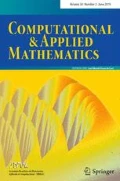Abstract
Stochastic \(R_0\) matrix, which is a generalization of \(R_0\) matrix, is instrumental in the study of the stochastic linear complementarity problem (SLCP). In this paper, we focus on the expected residual minimization (ERM) of the SLCP via the Fischer–Burmeister (FB) function, which enjoys better properties of the continuity and differentiability than the min-function-based ERM when the involved matrix is a stochastic \(R_0\) matrix. First, we prove that the solution set of the FB-function-based ERM is nonempty and bounded if and only if the involved matrix is a stochastic \(R_0\) matrix. Second, we show that its objective function is continuously differentiable in \({\mathbb {R}}^n\), which makes it possible for us to design the gradient-type algorithm. Finally, we implement the numerical experiments generated randomly via sample average approximation, and the numerical results indicate that the optimal solutions of the FB-function-based ERM are better than that of the min-function-based ERM in terms of preserving the nonnegativity of the involved linear function, especially when the involved matrix is a constant matrix.



Similar content being viewed by others
References
Agdeppa RP, Yamashita N, Fukushima M (2010) Convex expected residual models for stochastic affine variational inequality problems and its application to the traffic equilibrium problem. Pacific J Opt. 6:3–19
Che ML, Qi LQ, Wei YM (2019) Stochastic \(R_0\) tensors to stochastic tensor complementarity problems. Opt Lett 13:261–279
Chen XJ, Fukushima M (2005) Expected residual minimization method for stochastic linear complementarity problems. Math Oper Res 30:1022–1038
Chen XJ, Zhang C, Fukushima M (2009) Robust solution of monotone stochastic linear complementarity problems. Math Program 117:51–80
Chen XJ, Wets RJ-B, Zhang YF (2012) Stochastic variational inequalities: residual minimization smoothing sample average approximations. SIAM J Opt 22:649–673
Chen XJ, Pong TK, Wets RJ-B (2017) Two-stage stochastic variational inequalities: an ERM-solution procedure. Math Program 165:71–111
Chen XJ, Sun HL, Xu HF (2018) Discrete approximation of two-stage stochastic and distributionally robust linear complementarity problems. Math Program 177:255–289
Clarke FH (1983) Optimization and nonsmooth optimization. Wiley, New York
Cottle RW, Pang J-S, Stone RE (1992) The linear complementarity problems. Academic Press, Boston
Du SQ, Che ML, Wei YM (2020) Stochastic structured tensors to stochastic complementarity problems. Comput Opti Appl 75:649–668
Facchinei F, Pang J-S (2003) Finite-dimensional variational inequalities and complementarity problems. Springer, New York
Facchinei F, Soares J (1997) A new merit function for nonlinear complementarity problems and a related algorithm. SIAM J Opt 7:225–247
Fang HT, Chen XJ, Fukushima M (2007) Stochastic \(R_0\) matrix linear complementarity problems. SIAM J Opt 18:482–506
Folland GB (1984) Real analysis: modern techniques and their applications. Wiley, New York
Gürkan G, Özge AY, Robinson SM (1999) Sample-path solution of stochastic variational inequalities. Math Program 84:313–333
Huang YK, Liu HW, Yu TT (2016) Smoothing projected cyclic Barzilai–Borwein method for stochastic linear complementarity problems. Inter J Comput Math 93:1188–1199
Jiang HY, Xu HF (2008) Stochastic approximation approaches to the stochastic variational inequality problem. IEEE Trans Autom Control 53:1462–1475
Krejić N, Jerinkić NK, Rapajić S (2016) Barzilai-Borwein method with variable sample size for stochastic linear complementarity problems. Optim 65:479–499
Ling C, Qi LQ, Zhou GL, Caccetta L (2008) The SC1 property of an expected residual function arising from stochastic complementarity problems. Oper Res Lett 36:456–460
Liu HW, Huang YK, Li XL (2011) Partial projected Newton method for a class of stochastic linear complementarity problems. Numer Alg 58:593–618
Liu ZM, Du SQ, Wang RY (2016) Nonsmooth Levenberg-Marquardt type method for solving a class of stochastic linear complementarity problems with finitely many elements. Alg 9:83
Luo MJ, Lin GH (2009) Expected residual minimization method for stochastic variational inequality problems. J Opti Theory Appl 140:103–116
Ming ZY, Zhang LP, Qi LQ (2020) Expected residual minimization method for monotone stochastic tensor complementarity problem. Comput Opt Appl 77:871–896
Rockafellar RT, Sun J (2019) Solving monotone stochastic variational inequalities and complementarity problems by progressive hedging. Math Program 174:453–471
Rockafellar RT, Sun J (2020) Solving Lagrangian variational inequalities with applications to stochastic programming. Math Program 181:435–451
Rockafellar RT, Wets RJ-B (2017) Stochastic variational inequalities: single-stage to multistage. Math Program 165:291–330
Tang J, Ma CF (2011) A smoothing Newton method for solving a class of stochastic linear complementarity problems. Nonlin. Anal.: Real World Appl. 12, 3585C-3601
Tseng P (1996) Growth behavior of a class of merit functions for the nonlinear complementarity problem. J Opt Theory Appl 89:17–37
Wang MZ, Ali MM (2014) On the ERM formulation and a stochastic approximation algorithm of the stochastic-\(R_0\) EVLCP. Ann Oper Res 217:513–534
Xie Y, Shanbhag UV (2016) On robust solutions to uncertain linear complementarity problems and their vairants. SIAM J Opt 26:2120–2159
Xu HF (2010) Sample average approximation methods for a class of variational inequality problems. Asia Pac J Oper Res 27:103–119
Zhang C, Chen XJ (2009) Smoothing projected gradient method and its application to stochastic linear complementarity problems. SIAM J Opt 20:627–649
Zhang M, Sun J, Xu HL (2019) Two-stage quadratic games under uncertainty and their solution by progressive hedging algorithms. SIAM J Opt 29:1799–1818
Zhou GL, Caccetta L (2008) Feasible semismooth Newton method for a class of stochastic linear complementarity problems. J Opt Theory Appl 139:379–392
Author information
Authors and Affiliations
Corresponding author
Additional information
Communicated by Yimin Wei.
Publisher's Note
Springer Nature remains neutral with regard to jurisdictional claims in published maps and institutional affiliations.
This work was supported by the National Natural Science Foundation of China (Grant No. 11771244).
Rights and permissions
About this article
Cite this article
Cui, X., Zhang, L. Stochastic \(R_0\) matrix linear complementarity problems: the Fischer–Burmeister function-based expected residual minimization. Comp. Appl. Math. 40, 183 (2021). https://doi.org/10.1007/s40314-021-01571-x
Received:
Revised:
Accepted:
Published:
DOI: https://doi.org/10.1007/s40314-021-01571-x
Keywords
- Stochastic linear complementarity problem
- Stochastic \(R_0\) matrix
- Expected residual minimization
- Fischer–Burmeister NCP function




